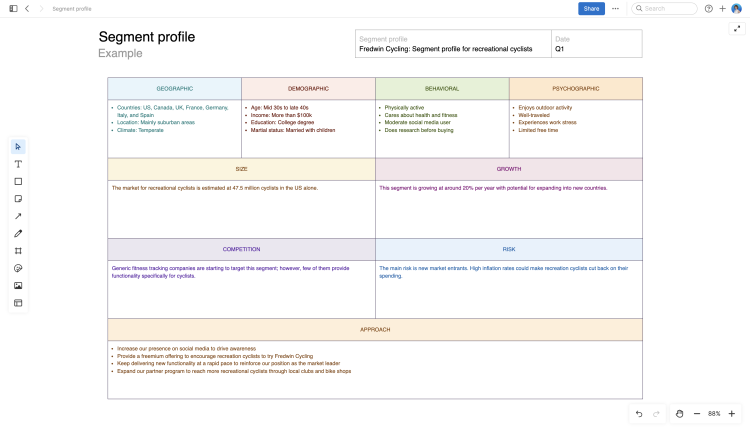Segment profile template
Capture the characteristics, growth opportunity, and likelihood of success for each market segment
Use template
About the segment profile template
What do your customers really need? Answering this question can be hard — especially if you serve a broad market with a large customer base. Identifying segments and creating a profile for each one helps you hone in on distinct groups of customers. By understanding shared behaviors and preferences within a particular segment, you can determine who you want to serve and how to tailor your products, services, and marketing strategies to meet their needs.
Use this template to capture the characteristics that make each segment unique — such as where they are located, what they value, and how they tend to make purchasing decisions. It is also important to consider the size, growth rate, and competitive landscape for each segment to assess the overall business opportunity.
The traits of a customer segment may change over time, so ongoing research and analysis are crucial. Update your segment profiles and make them readily accessible to the team — so you can stay relevant and adapt to changing consumer needs.
How to use the segment profile template
Evaluate each market segment that you want to engage.
Define segments Use market research and customer data to segment your customers into target groups. Broadly speaking, a segment should reflect this criteria: have the same primary needs; share geographic, demographic, and psychographic characteristics; and respond similarly to marketing techniques.
Define the market landscape Assess the size and growth opportunity of your target segment. Identify any competitors that serve the same segment and note any other risk factors that will impact your likelihood of success. Ideally, you want to prioritize segments that are most likely to respond well to your offering and will grow over time.
Validate the information Invite core teams across the organization to collaborate within the whiteboard. Add comments, questions, and insights to broaden everyone's understanding of each segment.
Consider your approaches Your unique product and situation will dictate next steps. For instance, you might want to write unique messaging and positioning for each segment, build distinct marketing campaigns, or adapt existing product offerings.